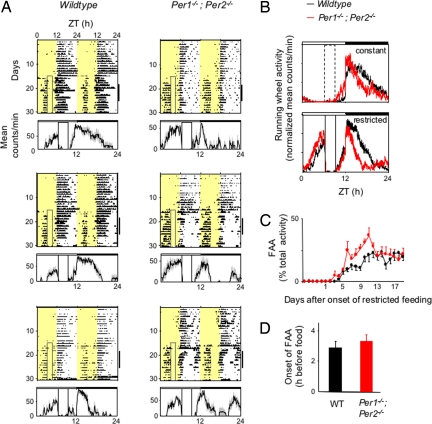Fig. 2.
Normal FAA in Per1−/−; Per2−/− double-mutant mice. (A) Representative double-plotted actograms of daily running-wheel activity of 3 wild-type and 3 Per1−/−; Per2−/− mice (as indicated) during constant food availability and under subsequent temporal food restriction. Data are displayed as in Fig. 1A. Under a light–dark cycle, Per1−/−; Per2−/− mice show a diurnal variation in locomotor activity because of the acute suppressive effect of light on behavior. (B) Mean locomotor activity profiles of wild-type (n = 9) and Per1−/−; Per2−/− mice (n = 8) under constant food availability (Upper) and after subsequent temporal food restriction (Lower). Data are displayed as in Fig. 1B. (C) Time course of the development of FAA in wild-type and Per1−/−; Per2−/− mice (n = 8 for each genotype). Data are displayed as in Fig. 1C. (D) Number of hours by which FAA anticipated daily food availability in wild-type and Per1−/−; Per2−/− mice (n = 8 for each genotype). Data are displayed as in Fig. 1D. The difference between genotypes is not statistically significant.

